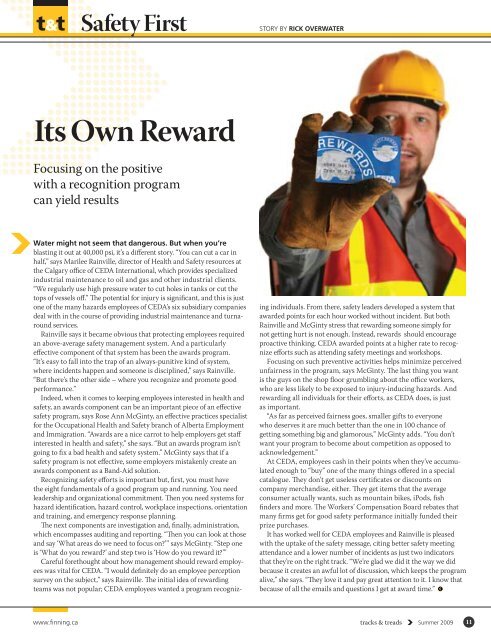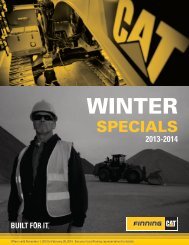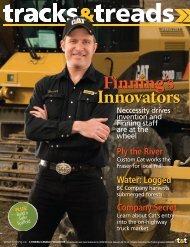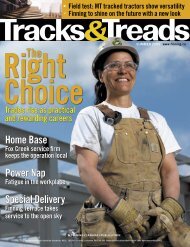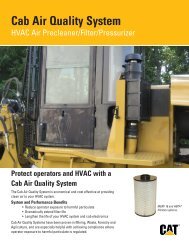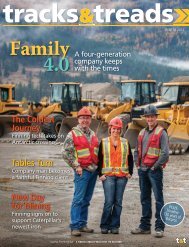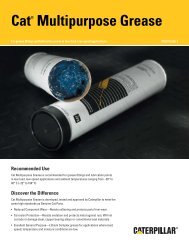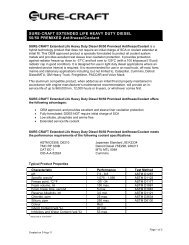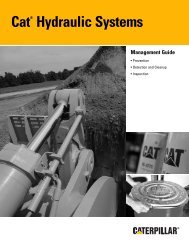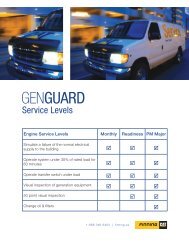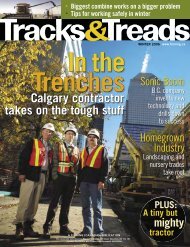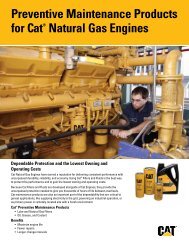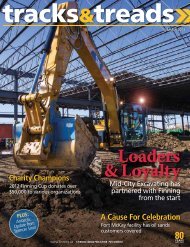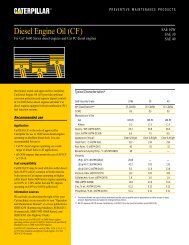Special Report - Finning Canada
Special Report - Finning Canada
Special Report - Finning Canada
You also want an ePaper? Increase the reach of your titles
YUMPU automatically turns print PDFs into web optimized ePapers that Google loves.
story By Rick OverwaterIts Own RewardFocusing on the positivewith a recognition programcan yield resultsWater might not seem that dangerous. But when you’reblasting it out at 40,000 psi, it’s a different story. “You can cut a car inhalf,” says Marilee Rainville, director of Health and Safety resources atthe Calgary office of CEDA International, which provides specializedindustrial maintenance to oil and gas and other industrial clients.“We regularly use high pressure water to cut holes in tanks or cut thetops of vessels off.” The potential for injury is significant, and this is justone of the many hazards employees of CEDA’s six subsidiary companiesdeal with in the course of providing industrial maintenance and turnaroundservices.Rainville says it became obvious that protecting employees requiredan above-average safety management system. And a particularlyeffective component of that system has been the awards program.“It’s easy to fall into the trap of an always-punitive kind of system,where incidents happen and someone is disciplined,” says Rainville.“But there’s the other side – where you recognize and promote goodperformance.”Indeed, when it comes to keeping employees interested in health andsafety, an awards component can be an important piece of an effectivesafety program, says Rose Ann McGinty, an effective practices specialistfor the Occupational Health and Safety branch of Alberta Employmentand Immigration. “Awards are a nice carrot to help employers get staffinterested in health and safety,” she says. “But an awards program isn’tgoing to fix a bad health and safety system.” McGinty says that if asafety program is not effective, some employers mistakenly create anawards component as a Band-Aid solution.Recognizing safety efforts is important but, first, you must havethe eight fundamentals of a good program up and running. You needleadership and organizational commitment. Then you need systems forhazard identification, hazard control, workplace inspections, orientationand training, and emergency response planning.The next components are investigation and, finally, administration,which encompasses auditing and reporting. “Then you can look at thoseand say ‘What areas do we need to focus on?’’’ says McGinty. “Step oneis ‘What do you reward?’ and step two is ‘How do you reward it?’”Careful forethought about how management should reward employeeswas vital for CEDA. “I would definitely do an employee perceptionsurvey on the subject,” says Rainville. The initial idea of rewardingteams was not popular; CEDA employees wanted a program recognizingindividuals. From there, safety leaders developed a system thatawarded points for each hour worked without incident. But bothRainville and McGinty stress that rewarding someone simply fornot getting hurt is not enough. Instead, rewards should encourageproactive thinking. CEDA awarded points at a higher rate to recognizeefforts such as attending safety meetings and workshops.Focusing on such preventive activities helps minimize perceivedunfairness in the program, says McGinty. The last thing you wantis the guys on the shop floor grumbling about the office workers,who are less likely to be exposed to injury-inducing hazards. Andrewarding all individuals for their efforts, as CEDA does, is justas important.“As far as perceived fairness goes, smaller gifts to everyonewho deserves it are much better than the one in 100 chance ofgetting something big and glamorous,” McGinty adds. “You don’twant your program to become about competition as opposed toacknowledgement.”At CEDA, employees cash in their points when they’ve accumulatedenough to “buy” one of the many things offered in a specialcatalogue. They don’t get useless certificates or discounts oncompany merchandise, either. They get items that the averageconsumer actually wants, such as mountain bikes, iPods, fishfinders and more. The Workers’ Compensation Board rebates thatmany firms get for good safety performance initially funded theirprize purchases.It has worked well for CEDA employees and Rainville is pleasedwith the uptake of the safety message, citing better safety meetingattendance and a lower number of incidents as just two indicatorsthat they’re on the right track. “We’re glad we did it the way we didbecause it creates an awful lot of discussion, which keeps the programalive,” she says. “They love it and pay great attention to it. I know thatbecause of all the emails and questions I get at award time.”www.finning.ca tracks & treads Summer 2009 32 11


